
In the evening of Thursday 17 October, at the parking place of the 'College Farm' in Shrivenham, Phil Judkins very kindly handed over to us the last remaining German 'bits and pieces' originating from late Graham Winbolt
Previously, we have already discussed the relevance of taking notice of single, often not entirely complete, artefacts; mainly based on Phil's snapshots.
Due to the circumstance that we currently are setting up the exhibition on "Secret Communications" to beheld within a few weeks in our museum premises, our first aim is to photograph the artefacts in in our laboratory, in a quite simple way . Maybe not the best place doing it, but as to discuss the items this means should be sufficient for the time being.
Most artefacts will be stored in a depot and not being directly visible to the public, anyway.
Graham Winbolt collected since late 1960s a huge quantity of 'electronic gear'. May we calling him a 'Collector'? It is my personal impression - that storing and preventing its destruction (scrapping) was his main aim. A collector is often creating a sort of 'system' in what he possesses or is doing. It is, however, not to say that he did not know where his very many items where being stored. He knew this astonishing well! Graham Winbolt did a great job in obtaining huge quantities of technical gear of all sorts; there can be no doubt about it!
Our Foundation is therefore very grateful that we got what remained in respect to German technology.
Most of which are valves of all kinds, essential for keeping our apparatus in a working order. Among it are very rare samples; some of which even exceptional.
The succession of artefacts shown below do not have a chronological order or sequence. The photographed succession follows the order of un-packing the versatile plastic boxes.
Graham Winbolt must have had particularly interest in 'Cathode Ray Tubes' considering the many around.

The way we received the many artefacts
Providing a good impression what the implications of unpacking means.
Phil Judkins did a very great job!
Page initiated on: 21 October 2013
Status: 25 October 2013
The occasion of handing over to us was combined with the annual DEHS Autumn Symposium (AS13). One of the reasons of joining is meeting old friends again.
The first artefact did not belong to Graham Winbolt's collection, but is a mystical glass envelope which function and purpose is unknown. I was told, that it was found in a box together with some British Navy gear, by a DEHS member who gave it kindly to us (have to apologise for having forgotten his name).
Our first query: Does some of you know what the next device is; where was it used for?
Was its purpose for high voltage or current protection?
(1)

The text is a mystery too

Its bottom side

Heinz Trochelmann suggested it might be a photo sensitive device
I don't think it is, because the centre hole is 'blind' (only a few mm deep which is vaguely visible).
(2)
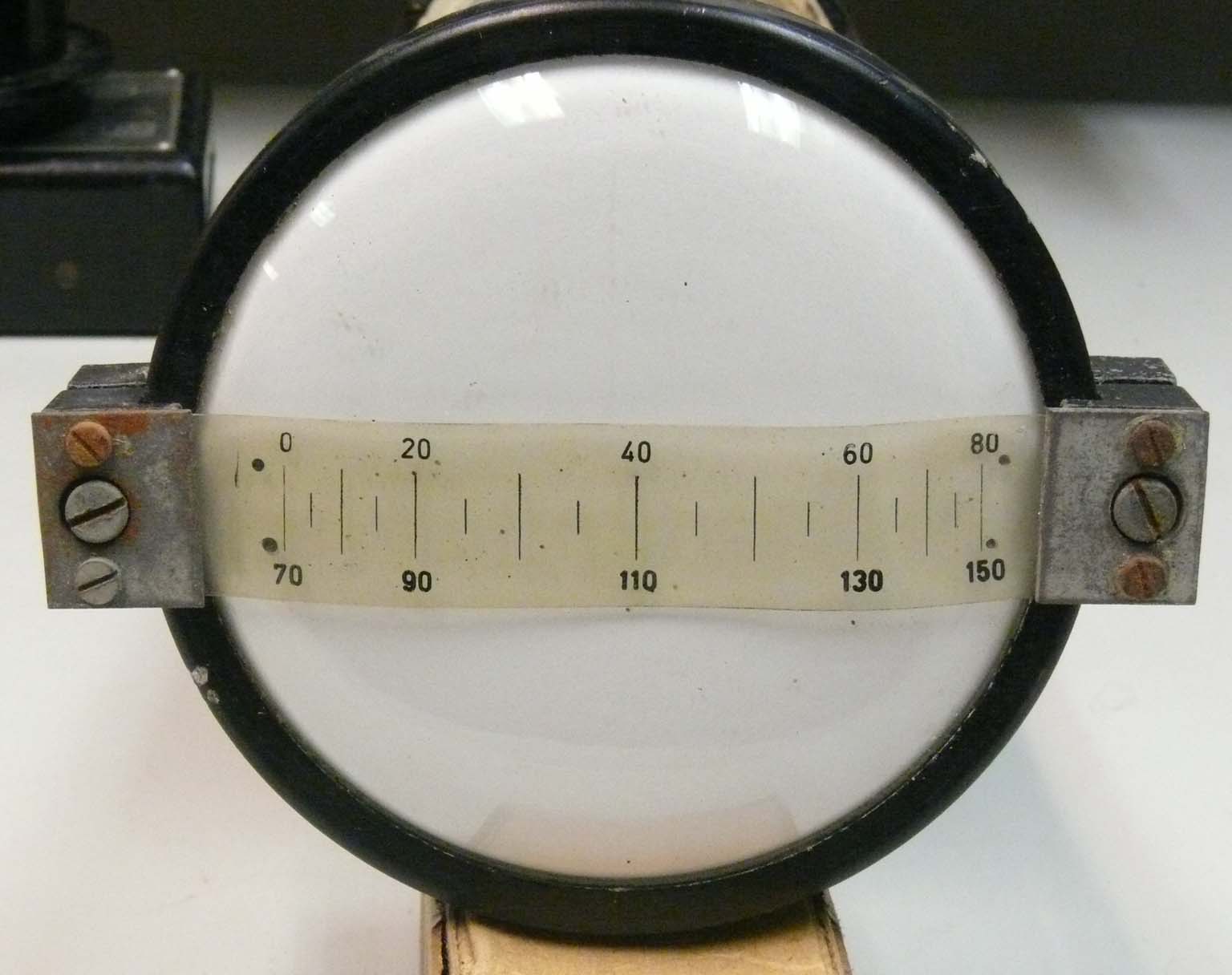
A regular AEG dual trace CRT type HR2/100/1,5
As it is not fit with a flat CRT screen we may assume that it originate from before or the early wartime days.
What makes it exceptional, is the curious ring-mounting around the screen section. Its purpose, very unconventionally, is to hold a transparent Mipolam strip. The upper scale showing a range of 0 to 80 km, the lower scale runs from 70 to 150 km.
My guess, it belonged to an early GEMA radar version; regarding the range most likely type Freya. When you look closely, the non linearity of the scales towards both scale ends may indicate that, like GEMA regularly did, derived their time-base deflection signal straight from a sine wave. It was regarded, that a part of a sine wave is having a linear slope the starting and ending ends where to be suppressed.

A closer look at the way the range scale was being mounted
(3)

Shown is the rare: Wecoveiver? valve type of about 1919
Heinz Trochelmann pointed:
Die Wecovalve ist der USA-Typ 215 (Peanut-Röhre), allerdings aus UK-Fertigung mit 4-Stift-Sockel für den europäischen Markt.
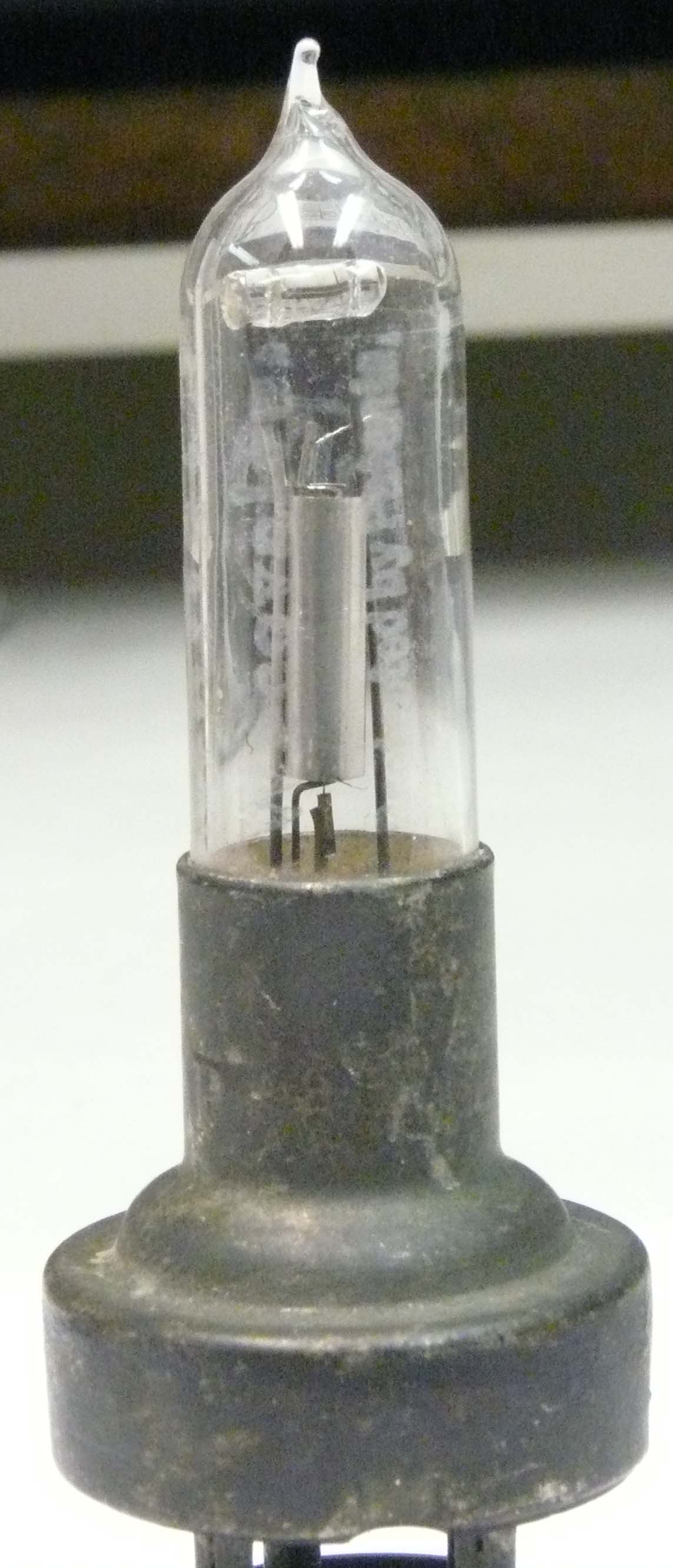
A closer look at the stamped or frosted information
For this occasion I choose a higher than usual photo resolution, as to allow you making a sound copy of it.
According Keith Thrower, it possesses an oxide cathode, which by then was not yet practised in Britain. He points that although, Mullard is mentioned being its manufacturer, it originated from US production.
(4)

A box meant for small M 2.6 x 5 mm screws
I must admit that I could not have dreamed that such metal boxes existed.

'Du' likely stood for Dral(uminium)
(5)

A box containing 100 x ED 704 UHF/SHF diodes
Its acceptance date: 28 December, likely 1944.
The red text on the box-seal on the left-hand side tells us that the diodes have been adjusted and that any means of mechanical tuning will deteriorate their performance. These miniature diodes where fit inside an about 3 to 4 mm ceramic tube having at both ends a brass contact arrangement, which in its centre being fit with a very tiny adjusting screw; I guess of Ø 1 mm!
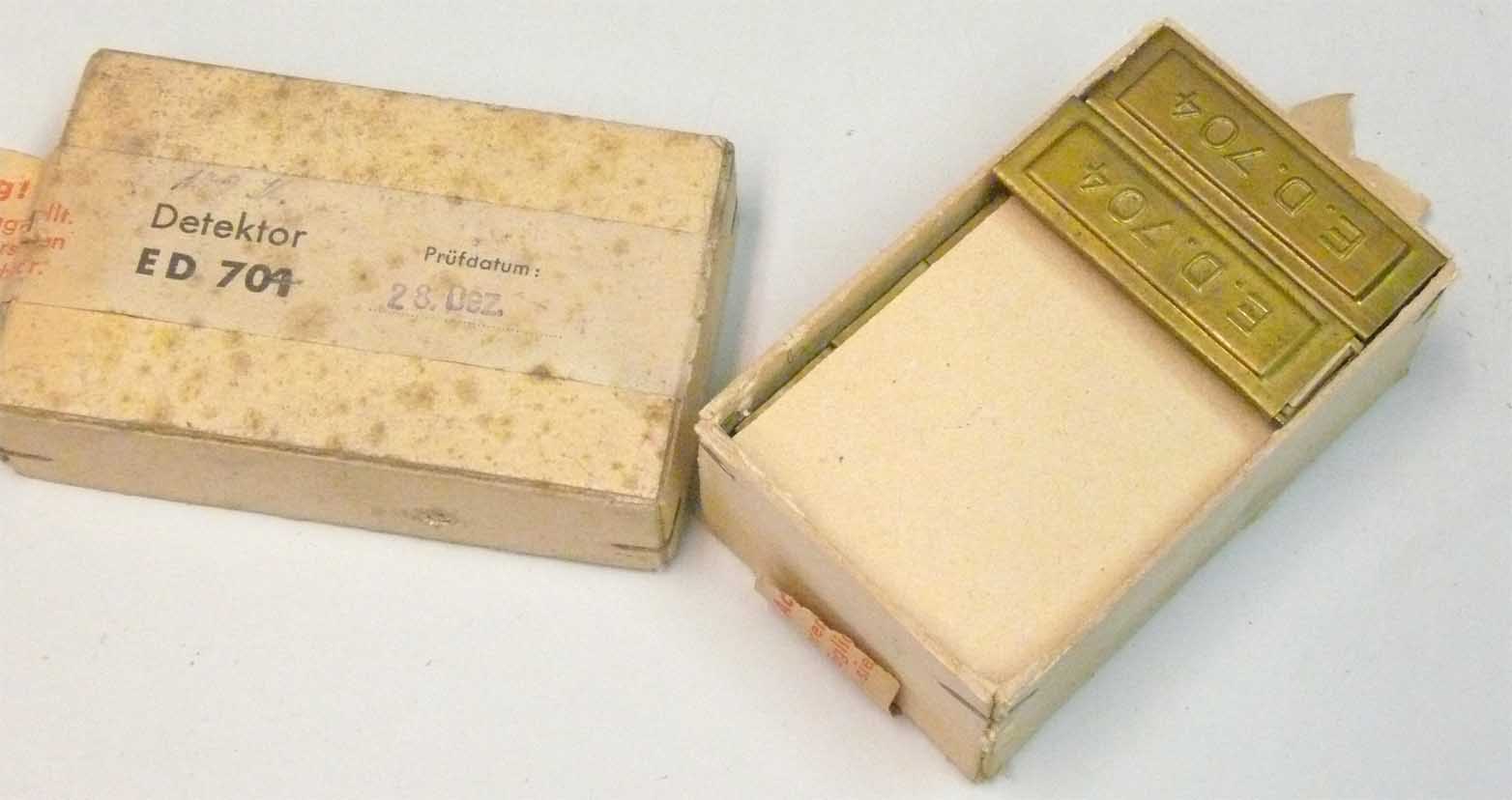
The box open
Each metal box containing a series of diodes
Apparently, three boxes are missing; one of which Graham Winbolt gave kindly to me in late 2004 when I collected the beautiful 'Luminous Quartz' devices. Lacking thus only two.

The upper layer being removed
Let us switch over, for the time being, to some non 'electronic' artefacts.
Among the many items is found a wooden box
(6)

The manufacturer of this instrument was: E. Leybold's Nachfolger A.G. Köln-Rhein Serial number No. 106
This is a well known company making instruments for educational purposes, but also for other means even after WW II, maybe still doing.
The three class envelopes contain salt crystals, what kind is not known

Inside the box lid this plate is found
Air Ministry Meteorological Office. (box) Made in Kew Observatory Workshop 22-9-30 (the separating dashed have been implemented)

The instrument being mounted at its tripod

The left-hand side tube cover being removed
We have not the slightest idea how this instrument should work, nor of the purpose of the pin, which apparently is controlled by means of the crank at the right-hand side of this instrument. A rather accurate 'Nonius' (scale reading) being provided.
Graham Wimbold was a GP, he therefore may have been interested in scientific instruments as well.

Another interesting finding is this Auction Label
On behalf of: Midland Marts Limited
Auctioneers
Bicester & Banbury
Lot number 2173
This kind of information is very interesting. as it might provide the route this device has travelled before it reached Graham's barn; and later came to Holland.
(7)

Another curious instrument
The disk arrangement can be taken out of the box
Please notice: that the top lid section appears distorted, because I have rotated this photo, owing to that this photo was taken from a side angle.

Inside its lid we learn that it is called: Ortungskreis
This label has been reproduced in an improved scanner resolution as to ease its reading.
Zweck des Instruments: Der Ortungskreis dient zur Eintragung des Schiffsortes, wenn die Kompaßdreiecke und der gewöhnliche Doppeltransporteur versagen. Dies ist insbesondere der Fall, wenn auf Schiffen, diie nur mit einem Magnetkompaß ausgerüstet sind, die Missweisung und die Deviation im Folge erdmagnetischer Störungen oder anderer unbekannte Einflüsse nicht mehr den bekannten Angaben der Seekarte und Deviationstabelle entsprechen. ....
(8)

Str.Tfl.A
Streckenzugtafel Type A
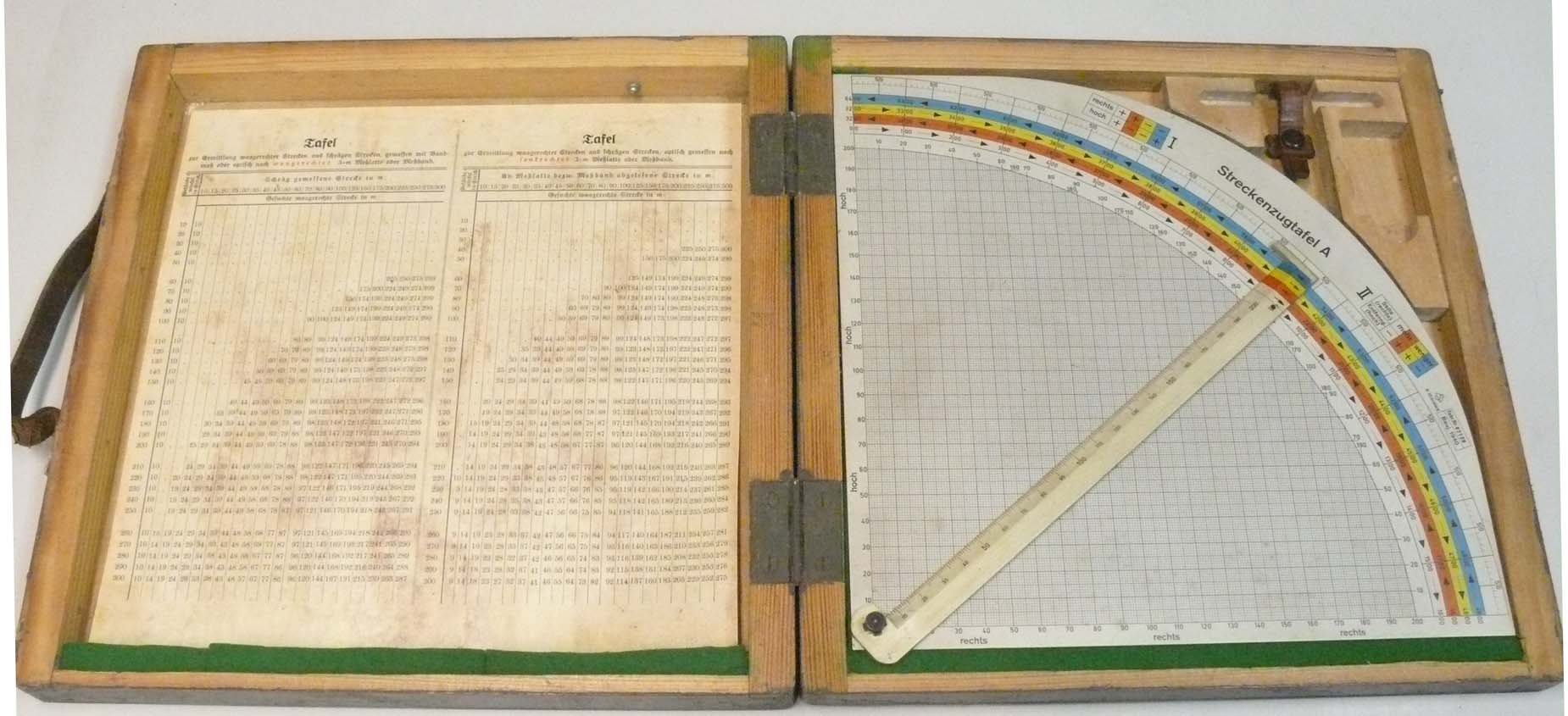
Its box being opened like a book

Streckenzutafel A
The calculation table

The horizontal and vertical plane tables
This photo has been reproduced in a higher than usual resolution as to allow its reproduction sufficiently.
I still have to admit that I do not understand how it should work.
(9)

Most likely a Philips two slit magnetron type TAM 10
Its base is the usual 4 pin 'European' socket. For this occasion I used a mountable valve base.
This type was once used by GEMA in their pre-war radar or UHF links (Richtfunk)

The two slit TAM 10 magnetron configuration shown in detail
Not visible is that the two cylinder sections are coming together just at the right-hand side (uniting to a single cylinder).
(10)

Shown is the 'breast-mounting' to the NS 4 the fighter pilot emergency transmitter
The transmitter signal originally was received by a FuG 141 DF receiver, but was later, what I have heard, was frequency converted and succeeded by the FuG16/17 spectrum.
Similar transmitter we posses already for decades since 1981
What often is missing is the mounting frame. Interestingly, this time we can see how it is being mounted and rarely also showing the 'pulling cord' with which it can be released.

Viewing the arrangement front the top
When the antenna strip being brought into an upward position the transmitter starts automatically transmitting.

Pulling this cord will move the module downwards and by this means releasing it from its mounting
The real pulling direction is thus downwards against a spring-loading and not what is shown!
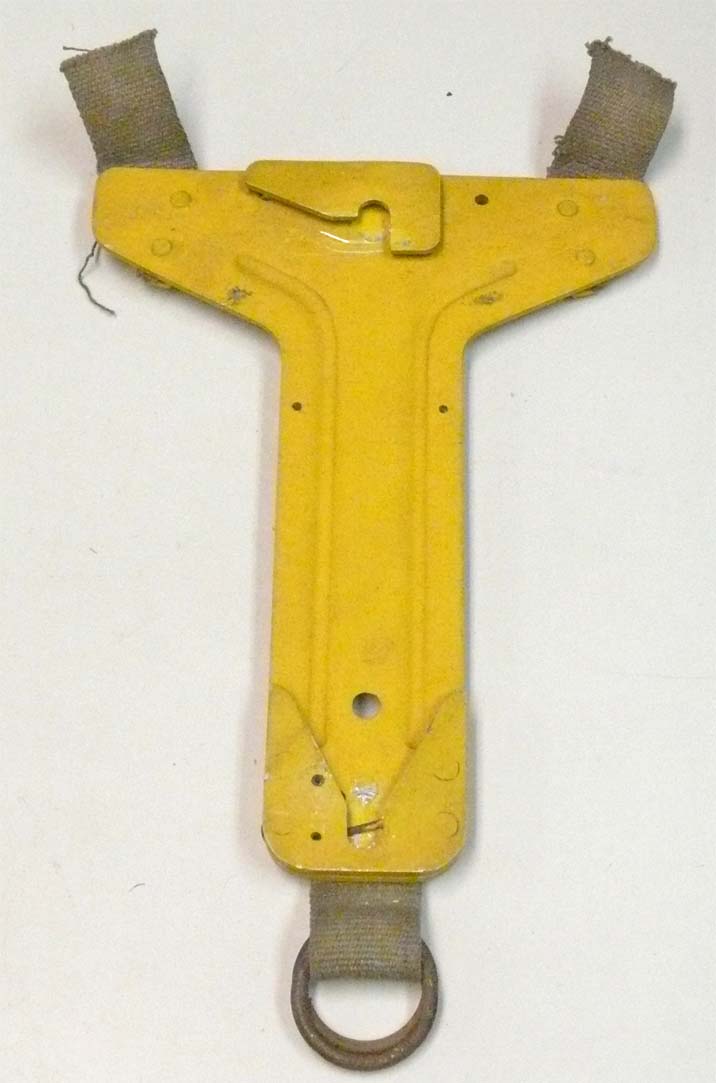
The mounting frame shown without mounting
After the module being pulled downwards it has to be slightly rotated anti-clockwise to released from its mounting.
Let us return again to the smaller devises
(11)

AEG thyratron type S0,35/0,35d, Maybe production code 'b q'
Filament 2 V, current 2.5 A

GAF property (R.L.M.) accepted in 1943 (week number not visible) 'Prüfer' used his individual stamp numbered 716
(12)

Shown is an American miniature CRT type 1CP1
On 25 October 2013
The new device is a Siemens power supply to the rare their very rare R IV receiver, with has some in common to the well-known HRO receiver, both using coil boxes. The R IV receiver uses a coil box mounted at the top side of the receiver.

Netzanschlußgerät für Empfänger R IV Nr. 4195

The power supply without housing
Seemingly, most is genuine, though, some open wires point that something is missing.

The way the rectifier valve type EZ12 can be accessed without taking off the metal cover
To be continued with page two on